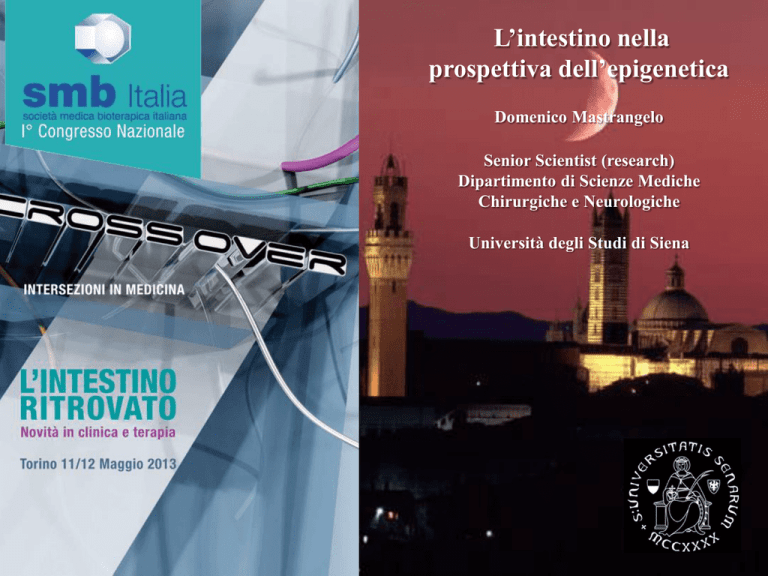
L’intestino nella
prospettiva dell’epigenetica
Domenico Mastrangelo
Senior Scientist (research)
Dipartimento di Scienze Mediche
Chirurgiche e Neurologiche
Università degli Studi di Siena
LA GENETICA MENDELIANA
GENE = porzione discreta di DNA che sintetizza una proteina
Espressione genica = sintesi di una proteina da parte di un gene
REGOLAZIONE GENETICA DELL’ESPRESSIONE GENICA
Human Genome Project (HGP)
- 3,6 miliardi di paia di basi nel DNA genomico
- costo dell’HGP – 2,7 miliardi dollari
- numero di geni umani previsto > 100.000
- Drosophila 14.000 geni, pollo 23.000 geni; mais 59.000 geni; uomo 25.000 geni
Geni che codificano proteine
Pseudogeni
DNA non codificante
Sequenze uniche
DNA non codificante
Sequenze ripetitive
Spazzatura???
Spazzatura???
Spazzatura???
IL “MICROCOSMO” (DNA)
Atomi
6%
Energia
Oscura
23%
Materia
Oscura
73%
IL “MACROCOSMO” (Universo)
98% of human chromosomes
are “junk” DNA between genes.
Large sections are remnants of
viral and bacterial infections
THE MYTH OF “JUNK” DNA
…
last
fall,
scientists
with
the
international ENCODE (the Encyclopedia Of
DNA Elements) consortium, launched by the
National Genome Research Institute in 2003,
announced what the authors said was a
breakthrough in identifying all the functional
elements in the human genome sequence.
Published across 30 papers in Nature, the
consortium claimed that long stretches of
DNA, previously dismissed as “junk”, are in
fact crucial to the way our genome works …
Collectively, the papers describe
1,640 data sets generated across 147
different cell types. Among the
many important results there is one
that stands out above them
all: more than 80% of the human
genome's components have now
been assigned at least one
biochemical function.
LA GENETICA MENDELIANA NON SPIEGA …
… come si possa generare tanta diversità fenotipica e complessità
funzionale a partire da uno stesso (ed unico) DNA! …
MUTAZIONI
alterazioni della struttura del DNA …
… o dei cromosomi di cui
il DNA rappresenta l’ossatura …
EPIGENETICA
… il termine fu coniato nel 1942 da Conrad Hal
Waddington, per definire: “ … lo studio delle
modificazioni ereditabili dell’ espressione genica
o del fenotipo cellulare, non legate a
cambiamenti della struttura del DNA.”
MECCANISMI DI REGOLAZIONE EPIGENETICA
DELL’ESPRESSIONE GENICA
MECCANISMI DI REGOLAZIONE EPIGENETICA
DELL’ESPRESSIONE GENICA
MECCANISMI DI REGOLAZIONE EPIGENETICA
DELL’ESPRESSIONE GENICA
MECCANISMI DI REGOLAZIONE EPIGENETICA
DELL’ESPRESSIONE GENICA
Una sola cellula… un solo DNA e … migliaia di fenotipi cellulari …
Il DNA delle cellule germinali presenta numerosi “tags” epigenetici in
quanto tutte le cellule di un individuo adulto sono “specializzate” per
svolgere compiti definiti. Con la fecondazione questi “tags” vengono
rimossi e l’oocita può trasformarsi in qualsiasi tipo di cellula …
L’EPIGENETICA (non la genetica mendeliana!) SPIEGA …
… come si possa generare tanta diversità fenotipica e complessità
funzionale a partire da una singola cellula! …
EPIGENETICA
Principi:
1. L’espressione genica non dipende (solo) da
cambiamenti (mutazioni) nella struttura del DNA
2. Il “fenotipo” cellulare” (l’aspetto e le
caratteristiche di una cellula) non è dovuto (solo)
a cambiamenti (mutazioni) della struttura del
DNA
3. Un “fenotipo” cellulare può essere ereditato
indipendentemente da cambiamenti (mutazioni)
nella struttura del DNA
Epigenetics, or why the question isn't
"Environment OR Genetics"
ENVIRONMENT = The combination of external
physical conditions that affect and influence the
growth, development, and survival of organisms
… environmental factors may exert neurobiological
and behavioral effects through epigenetic changes.
“Environment” in this context can be used in the very
broad sense and include hormonal, social,
nutritional, and toxicological exposures occurring
prenatally, postnatally, or in adulthood. During
prenatal development, adverse experiences are
associated with a heightened risk of physical and
psychiatric dysfunction … (Champagne FA, Risman EF:
Behavioral epigenetics: A new frontier in the study of hormones and
behavior. Hormones and Behavior 59 (2011) 277–278)
Beta-adrenergic signaling from the sympathetic nervous
system has been found to up-regulated a diverse array of
genes that contribute to tumor progression and
metastasis, whereas glucocorticoid-regulated genes can
inhibit DNA repair and promote cancer cell survival and
resistance to chemotherapy… (Cole SW: Nervous system regulation
of the cancer genome. Brain, Behavior, and Immunity 30 (2013) S10–S18)
Jean-Baptiste Lamarck (1744-1829) is best remembered
for a discredited theory of heredity, the "inheritance of
acquired traits." He proposed that environment changes
caused changes in behavior which in turn led to the
increase or decrease of particular structures. Lamarck
had a colorful and distinguished career: in turns soldier,
bank clerk, Professor of "insects and worms" he died a
poor man and was buried in a rented grave.
It is increasingly recognized that environmental exposure to chemical, nutritional and
behavioral factors alters gene expression and affects health and disease by not only
mutating promoter and coding regions of genes, but also by modifying the epigenome.
Faulk C, Dolinoy DC: Timing is everything: The when and how of environmentally induced
changes in the epigenome of animals Epigenetics 6:7, 791-797; July 2011;
CANCER EPIGENETICS
L’ereditarietà dei caratteri acquisiti …
J.B. Lamarck
?
a) Dietary supplementation
of female mice during
pregnancy. The diets of
female
a/a
mice
are
supplemented with methyldonating substances (that is,
folic acid, choline, vitamin
B12 and betaine) or the
phytoestrogen genistein 2
weeks before mating with
male Avy/a agouti mice, and
throughout pregnancy and
lactation
b)
Maternal
dietary
supplementation and coatcolour
distribution
in Avy/a offspring. The coat
colour is primarily yellow in
the offspring that are born to
unsupplemented
mothers,
whereas it is mainly brown in
the offspring from mothers
that were supplemented with
methyl-donating compounds
or genistein.
?
L’intestino è la sede principale del sistema immunitario …
L’epigenetica e’ alla base del funzionamento del sistema immunitario
During the differentiation of T and B cells, immune-receptor loci in the genome must be made sterically accessible
so that they can undergo rearrangement. Here, we discuss how this is carried out by the stepwise removal of
epigenetic repression mechanisms — such as later-replication timing, heterochromatization, histone hypoacetylation and DNA methylation — in a manner that initially favours one allele in each cell. We propose that this
mechanism of allelic exclusion might also be the basis for the generation of gene diversity in other systems.
L’epigenetica e’ alla base del funzionamento del sistema immunitario
L’epigenetica e’ alla base del funzionamento del sistema immunitario
L’epigenetica e’ alla base del funzionamento del sistema immunitario
THE HUMAN MICROBIOME
The human microbiome refers to all of the microbial organisms that reside in the
body including bacteria, fungi, and archaea. Notably, the human body contains over
10 times more microbial cells than human cells!
… il rapporto cellule/batteri, nell’organismo
normale, è 1/10 (per ogni cellula, 10 batteri! …)
Through live-birth, mammals have important opportunities for mother-to-child microbial transmission
through direct surface contact. However, many modern practices can reduce organism and gene flow; several
examples are illustrated. After initial introductions, there is strong selection by hosts for microbes with
specific phenotypes, consistent with the extensive conservation shown in Fig. 1. Acquisition is modified by
differences in offspring genetics and epigenetics (with respect to both maternal and paternal genes) that
inform the competition for host resources by the vertically transmitted or environmentally acquired
microbes. Ancestral organisms that have particular tissue-specific and niche-specific adaptations facilitate
tissue tropisms and are selected for, thus explaining the conserved niche-specificity compositions.
THE GUT MICROBIOTA
… is part of the human microbiome …
THE GUT MICROBIOTA
… time to get a little dirty? …
… is part of the human microbiome …
THE GUT MICROBIOTA
Gut microbiota is an assortment of
microorganisms inhabiting the length
and width of the mammalian
gastrointestinal tract. The composition
of this microbial community is host
specific, evolving throughout an
individual's lifetime and susceptible to
both exogenous and endogenous
modifications.
Composition and luminal concentrations of dominant microbial species in
various regions of the gastrointestinal tract.
THE GUT MICROBIOTA
THE GUT MICROBIOTA
… and the epigenetic regulation of the immune system …
THE GUT MICROBIOTA
… and the “environment” ……
THE GUT MICROBIOTA
… the multiple low-molecular-weight
substances
of
indigenous
gut
microbiota origin should be considered
one of the main endogenous factors
actively participating in epigenomic
mechanisms that are responsible for the
mammalian genome reprograming and
post-translated modifications.
Gut
microecological imbalance caused by
various biogenic and abiogenic agents
and factors can produce different
epigenetic abnormalities and the onset
and progression of metabolic diseases
associated …
Shenderov BA et al: Gut indigenous microbiota and
Epigenetics. Microbial Ecology in Health & Disease
2012, 23: 17195 - DOI: 10.3402/mehd.v23i0.17195
THE GUT MICROBIOTA
The complex web of gut microbiota contributions to host physiology. Different gut microbiota components can affect many aspects of
normal host development, while the microbiota as a whole often exhibits functional redundancy. In gray are shown members of the
microbiota, with their components or products of their metabolism. In white are shown their effects on the host at the cellular or
organ level. Black ellipses represent the affected host phenotypes. Only some examples of microbial members/components
contributing to any given phenotype are shown. AMP, antimicrobial peptides; DC, dendritic cells; Gm−, Gram negative; HPA,
hypothalamus-pituitary-adrenal; Iap, intestinal alkaline phosphatase; PG, peptidoglycan; PSA, polysaccharide A.
THE GUT MICROBIOTA
… and health …
Gut microbiota now appears to
influence the host at nearly every
level and in every organ system,
highlighting our interdependence and
coevolution. Its adaptation to our
changing life-styles (such as diet- and
ethnicity-associated differences in gut
microbiota
composition)
is
astounding, highlighting that the
consequences of our behaviors affect
not only the environment without, but
also that within us.
Inna Sekirov, Shannon L. Russell, L. Caetano M. Antunes, and
B. Brett Finlay: Gut Microbiota in Health and Disease Physiol
Rev 90: 859–904, 2010; doi:10.1152/physrev.00045.2009.
THE BRAIN-GUT AXIS
… health … and epigenetics …
THE BRAIN-GUT AXIS
… health … and epigenetics …
THE BRAIN-GUT-MICROBIOTA AXIS
… health … and epigenetics …
The
novel
conceptual
model “Brain-Gut-Microbiota
Axis” has received emerging
attention recently
THE BRAIN-GUT-MICROBIOTA AXIS
… health … and epigenetics …
Gut microbes produce substance such as tryptophan-related metabolites
kynurenic acid, short chain fatty acids, and neurometabolites GABA,
noradrenalin, and dopamine that potentially target to and influence
functions of our central nervous systems.
… Mind altering microorganisms …
In the process of neurodevelopment, they modulate the expression level of many
critical genes, such as brain-derived neurotropic factor (BDNF), NMDA
receptors or 5-HT receptors and communicate with brain regions like striatum,
hippocampus, amygdale, hypothalamus, and cingulated gyrus.
… and microbiota altering brain …
It has long been known that the colonization of gut flora is related to the stress
response of the hosts, changing their states of anxiety and exploratory behavior.
Colorectal Cancer Epigenetics: Complex Simplicity

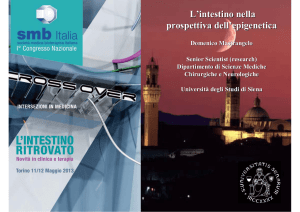


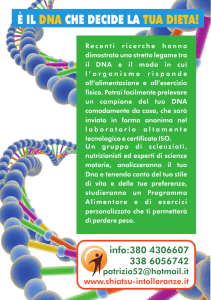
![mutazioni genetiche [al DNA] effetti evolutivi [fetali] effetti tardivi](http://s1.studylibit.com/store/data/004205334_1-d8ada56ee9f5184276979f04a9a248a9-300x300.png)
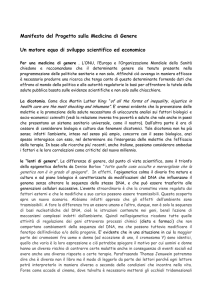
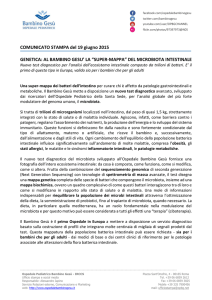
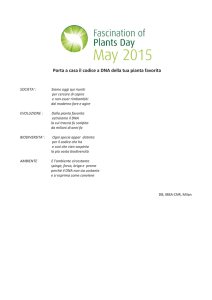
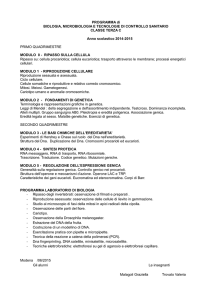
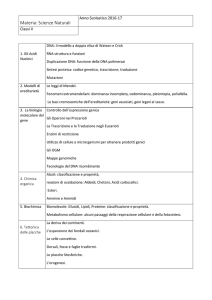
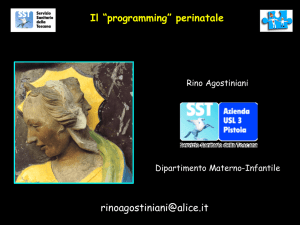
![(Microsoft PowerPoint - PCR.ppt [modalit\340 compatibilit\340])](http://s1.studylibit.com/store/data/001402582_1-53c8daabdc15032b8943ee23f0a14a13-300x300.png)